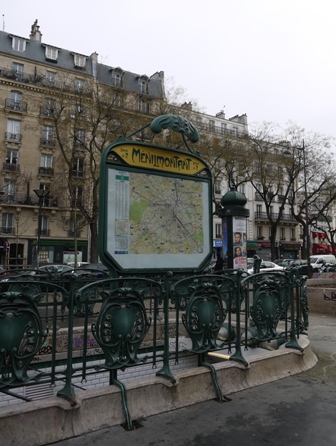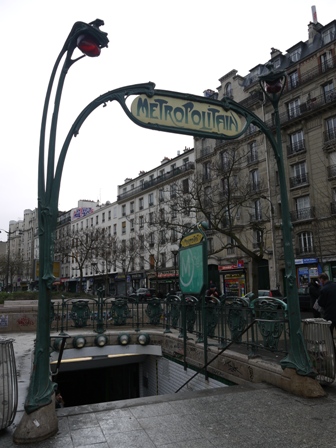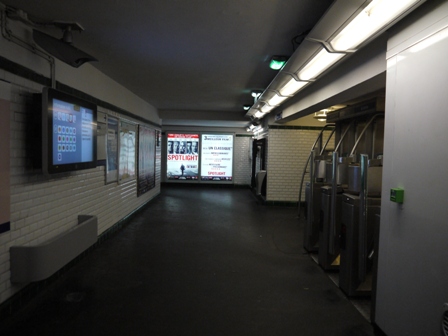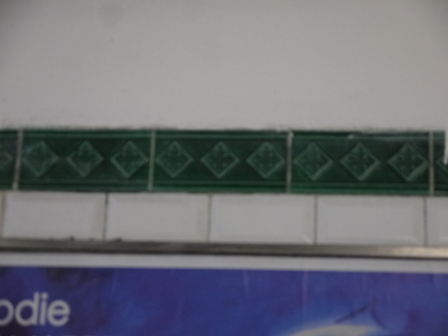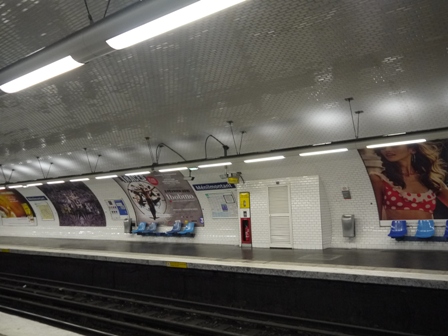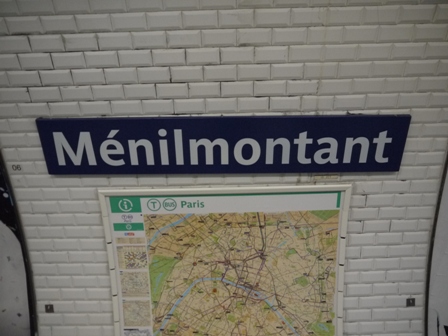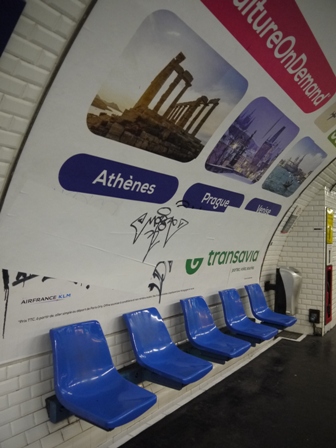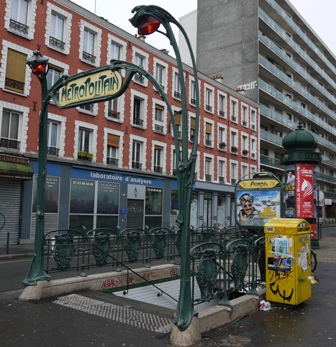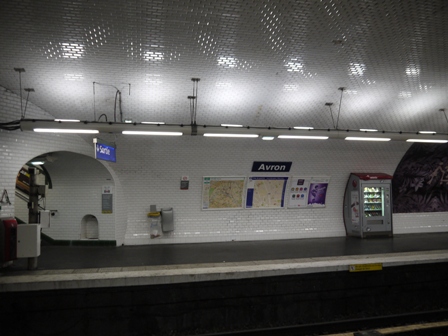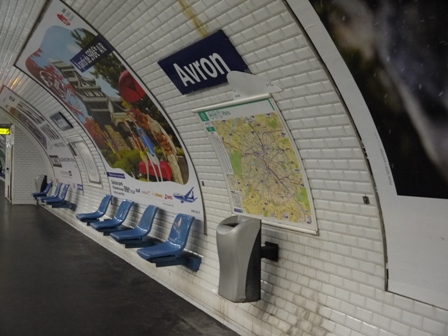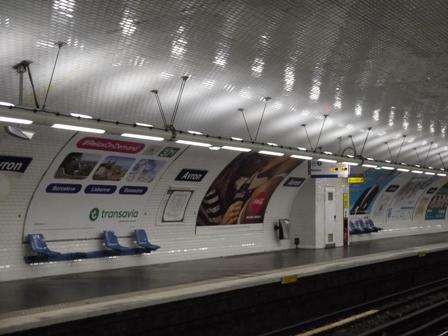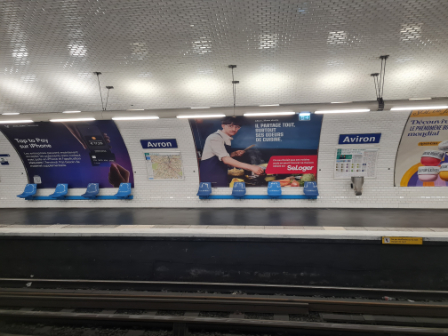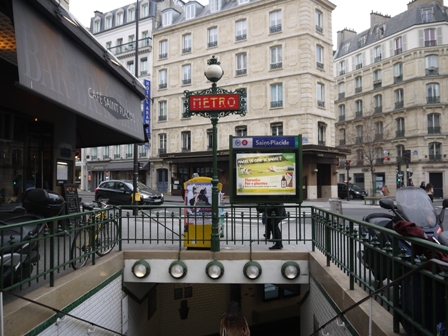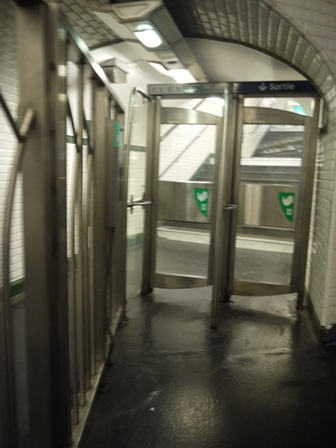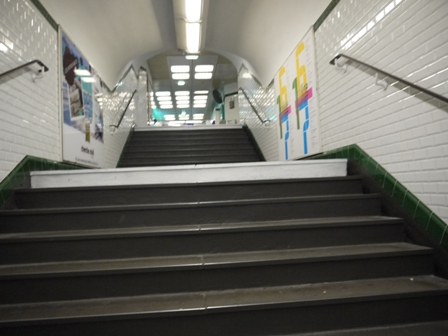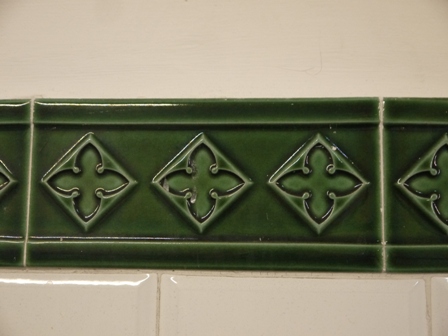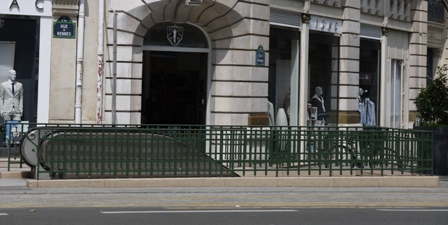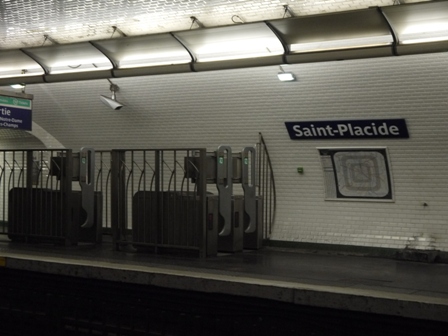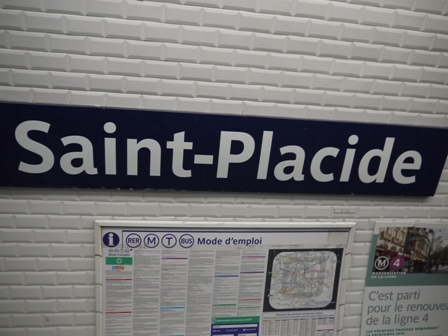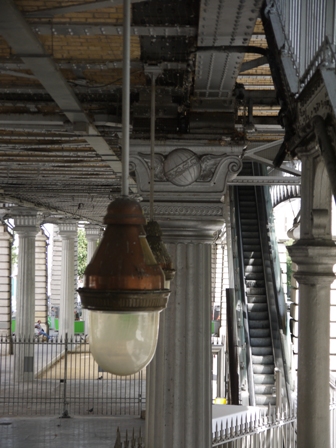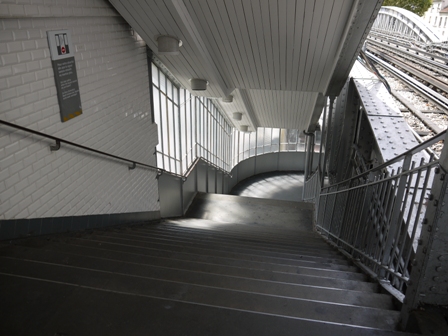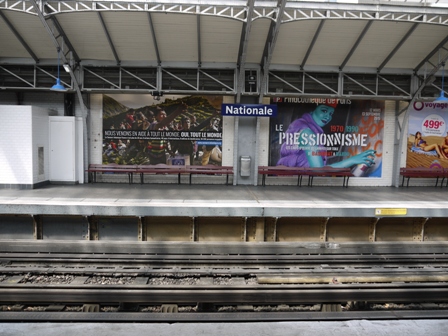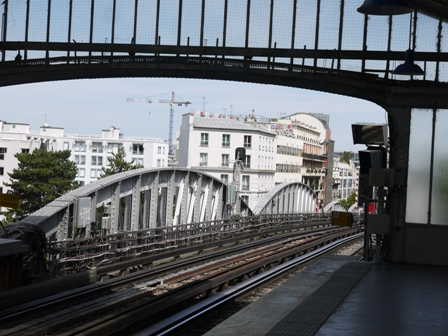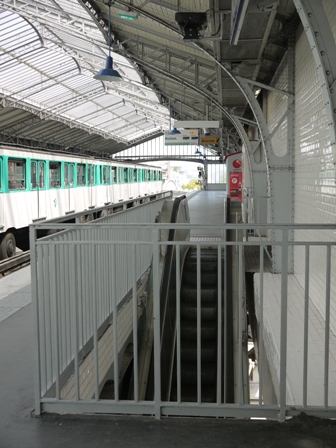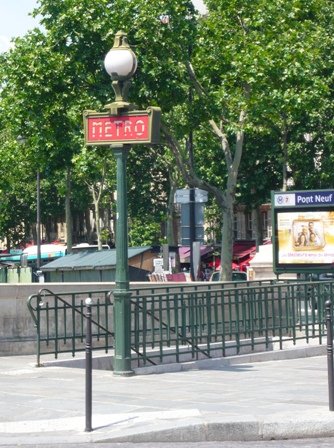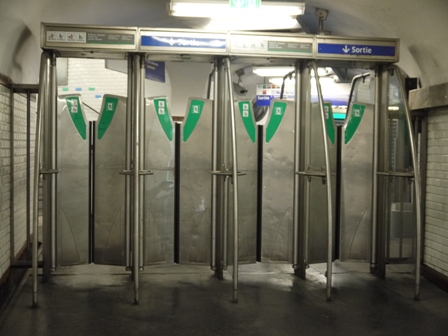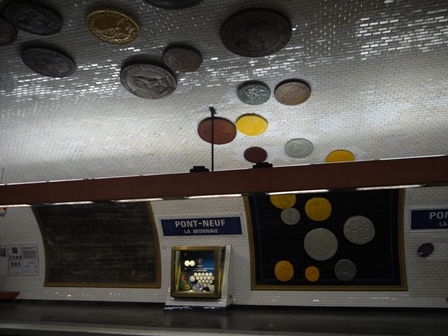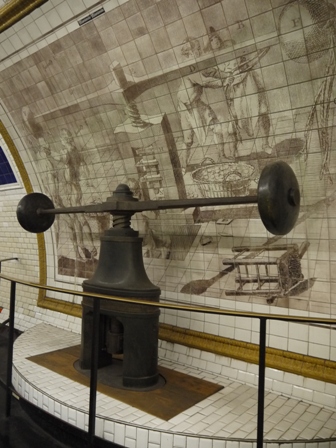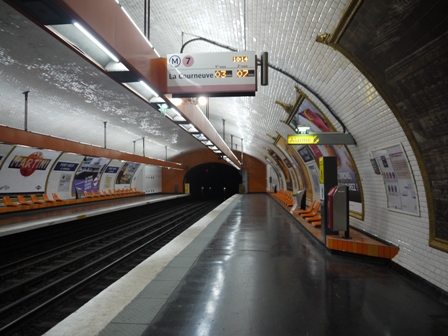- Details
The station opened on 31 January 1903 as part of the original section from Alexandre Dumas (then called Bagnolet) to Anvers.
Ménilmontant is situated on the border of the 11th and 20th arrondissements.
The underground station is served by the metro line 2.
The station sign is in the art nouveau style.
In the centre of the green metal panel is a map of the network. Above this is a narrow panel with the station name written in green on a yellow background using the art nouveau font. It also shows the number of the metro line.
Attached to the top is a green cupped flower light.
The station sign is attached to the Guimard fence and the ground.
The green fence is placed on a small stone sims.
The entrance to the station is not marked by an area of white raised circles.
On either side of the entrance is a large green lamppost in the shape of a flower with a red light.
Between the lampposts is a yellow oval sign with the the word Metropolitain written in green.
At the other end of the entrance, at ground level, are five small round lights in green fittings.
The back of the station sign shows a large metro logo. It is fixed to the side of the fence.
Metal handrails have been fitted to the tiled walls.
At the wall in the corridor is a display screen with traffic information of other lines and bus departures.
The walls are tiled nearly to the top. The ceiling is flat and painted white.
The walls in the corridor are tiled to about shoulder height in white rectangular tiles with a raised centre.
The green border tiles have a raised pattern of three diamonds with flowers.
The wall above the border and the ceiling are painted white.
The side platforms are not separated from the tracks by barriers.
The vaulted ceiling and the walls are tiled in white rectangular tiles with a raised centre, which reflect some of the light.
Lights in the form of a long tube are hung from the ceiling and fixed with pairs of wires.
The platform signage consists of the station name in white mixed-case letters on a dark blue background. The sign is not framed.
The sign has been placed on the tiled wall.
Underneath is a plan of the tram and bus network in a white frame.
Medium blue plastic seats have been screwed to a blue metal bar fixed to the wall.
Behind them are large advertising boards in thin metal frames.
- Details
Avron is situated on the border of the 11th and 20th arrondissements.
It is an underground station served by the metro line 2.
The station opened on 2nd April 1903 when the line was extended to Nation.
The entrance to the metro station is under an art nouveau sign, which is held up by two lampposts in the shape of flowers. They are painted dark green. Their lights are red.
The art nouveau sign has the word Metropolitain in green capital letters written on a yellow background.
Both the lampposts and the green fence panels designed by Guimard are fixed on a low stone border.
Metal hand rails are fixed on the tiled walls.
The entrance is marked by a wide white strip with raised circles.
Entrance to the side platforms is from the side towards to end of it.
The vaulted ceiling and the walls are tiled in small white rectangular tiles with a raised centre, the so-called metro tiles.
The platform has no barriers.
The platforms have been furnished with light blue plastic seats mounted on a blue metal bar fixed to the wall.
Behind the seats are advertising boards with thin metal borders.
The platform sign consists of white mixed-case lettering on a dark blue plasticized sign without frame.
Underneath the sign is a map of the transport network in a white frame.
The platform lights are in a long tube strung by pairs of wires from the tiled ceiling.
The platform edge is marked with a band of raised circles and a white line to help visually impaired passengers.
It is tradition for the RATP to take part in in the tradition of April Fools jokes.
In 2024 it renamed a number of stations to celebrate the olympic and para-olympic games which take place later that year, as well as to highlight the week of olympic and para-olympic games (2 - 6 April 2024).
For a day, the platform of this station was renamed to Aviron and Para Aviron.
- Details
The station opened on 9 January 1910 under the name Vaugirard when the section linked the north and south sections of the line. However, when a new station opened close by on the metro ligne 12, the name was changed to its present name - Saint-Placide, another street at proximity, which in turn takes it name from a church dedicated to Saint-Placide a Benedict monk of the 6th century.
Saint Placide is an underground station situated in the 6th arrondissement with no connections.
It is served by the metro line 4.
Entrance to the station. At the far side of the entrance, at the centre, is a lamppost of type "Val d‘Osne". Around the red METRO sign are small metal decorations.
Next to the lamppost is the station panel: a square metal box with the station name, the number of the metro line and a large area under glass where adverts are displayed.
The station is surrounded by a green metal fence consisting of round bars of equal lengths topped by little balls. Two metal hand rails are fixed to it and the side walls. The walls are tiled in small white tiles and a top row of green border tiles.
At ground level are five small round lights with a wide green metal rim.
The platform exit is through one of two metal doors with glass panels. Passengers have to push the metal strip for the doors to open.
The ground is painted grey.
Passengers go down to the platform on the other side of the tall stainless steel fence.
The stairs have two landings. The last step is painted white to highlight them. Large advertising panels in metal frames have been fixed to the walls at the landings.
The vaulted ceiling is painted white.
Metal hand rails on the walls guide users down the stairs.
The walls are tiled at the bottom and painted at the top.
Along the apex is a band of double light tubes. All lights in the metro stations is now LED.
At the bottom of the walls is a row of dark green plein tiles.
The border between the painted top and the tiled bottom is marked by a narrow row of green border tiles.
Each tile has three diamond shapes with a four-petalled flower in it.
It is possible to leave Saint-Placide by another exit. This exit only has an escalator leading to the surface.
Unlike the fence of the main entry, this fence is made of flat green metal bars.
The station has two side platforms. The tracks in the middle are separated by a low metal fence. The edges of the platforms are painted white.
The low-arched ceiling and the walls are tiled.
Seating is provided in the form of groups of medium blue plastic chairs fixed to the wall.
Advertising posters can be found in metal frames behind the seats.
Ticket validation is carried out at platform level. Passengers either introduce their paper ticket in the slot or place their electronic pass near the sensor of the entrance barrier. They then push the released barrier arm.
The silver light fittings have been designed by Bruno-Gaudin. The lights fixed on a lower metal bar are reflecting from the curved upper sheet.
The platform sign consists of white mixed letters on a blue plasticed bar without frame. It has been placed on white Metro tiles with a raised centre.
- Details
Nationale opened on 1 March 1909, it is an elevated station.
The station is situated in the 13th arrondissement.
It is served by the metro line 6. The station is named after the rue Nationale, which in turn is named to commemorate the National Guard. Created on 13 July 1789, the National Guard was a middle-class militia, taking part in the storming of the Bastille.
Copper topped drop-shaped lights are suspended by metal bars from underneath the tracks. The underside of the tracks is made of layers of bricks supported by stips of rivetted iron painted grey.
The tall columns supporting the platforms have been painted in light grey. They are topped with a decorated sledge and a sphere with wings and images of animals around the centre.
The station area is separated with a tall metal fence
The staircase from ground level to the platforms. For most parts the outside is made of frosted glass on a base of metal panels to increase the amount of light available.
Towards the last meters before the platform level, the wall has been tiled in small rectangular tiles with a raised centre. Two metal handrails have been fixed at the sides of the stairs.
The wood-panel ceiling above the stairs is painted white. A row of metal cylinder shaped lights has been place on the edge closest to the wall.
Seating is provided in the form of small benches made of wood and painted in a reddish brown. Behind them are advertising frames made of white ceramic tiles.
The signage is a dark blue plasticised sign with white mixed case letters. It is fixed on the vertical part of the strutts supporting the roof.
The roof over the platforms is panelled white.
Small lamps with light blue metal lampshades hang from the roof.
View of the entrance towards Chevarelet. The walls are made of frosted glass with metal wires.
The roof over the tracks is made of panels of frosted glass.
The edge of the platform is marked with a thck white line and a row of similar width of plastic tiles with raised circles.
The platforms can also be accessed via a narrow escalator. The escalator only runs from the lower level to the upper level.
- Details
The station opened on 16 April 1926.
It is situated in the 1st arrondissement, close to the Paris Mint. The underground station takes its name from Pont Neuf - the oldest bridge in Paris, although its name means "new bridge". At its time was the newest, all older bridges have since dissappeared.
The station is served by the metro line 7.
The narrow entrance is surrounded by a green metal enclosure made of bars of two different lengths.
The the right side is a green lamppost with a white globe light.
At the back is a green display cabinet with some advertising and the station name and number of metro line above it.
Four solid metal doors in metal frames mark the exit. The doors swing open in the middle when a pressure pad on the ground is pressed by approaching each door.
Large ceramic reproductions of coins have been fixed to the tiled ceiling, dropping into one of the advertising frame.
The frames are made of mustard coloured ceramic tiles with a cabbage leaf pattern.
Under the platform sign is a small showcase with coins.
One of the platforms displays a large coin press on a low pedestal behind a brass barrier.
Behind it is a painted monochrome scene on square tiles depicting a coin press in action.
The tracks are between the two platforms.
The walls and ceiling are tiled in small horizontal ceramic tiles with a raised centre.
Orange plastic seats have been placed on a base tiled with orange ceramic tiles.
Lights have been added in matching rectangular metal boxes fixed above the platform edge.
The electronic display sign shows line number and directorion - in this case La Courneuve -, the time and the waiting time until the next two trains.
The signage consists of large white letters on a background of dark blue, square ceramic tiles. Underneath in slightly smaller white letters is written LA MONNAIE (The Mint). The tiles are surrounded by a frame of white curved tiles.

